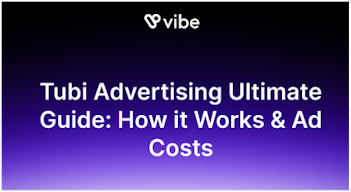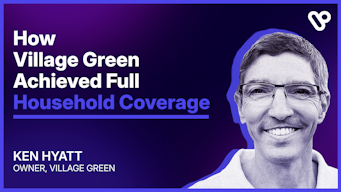How To Advertise on TV? [Its Cost + Best Practices]
TV advertising is a powerful way to reach a large audience, build trust, and drive sales—but it can feel complicated.
How much does it cost? Which type of TV ad works best? How do you ensure your campaign delivers results?
Without the right strategy, you risk overspending with little to no return. But If you get it right, you can reach thousands of engaged viewers and drive real results.
In this guide, you’ll learn:
- How TV advertising works and the best option for your business.
- The real cost of TV ads and what affects pricing.
- A simple, actionable process to launch a successful campaign.
- Best practices to maximize ROI and avoid wasted spend.
- How Vibe.co is making TV advertising smarter and easier.
By the end, you’ll know exactly how to advertise on TV the right way. Let’s get started!
Why TV Advertising Still Works in 2025
TV advertising still works because it holds attention, builds trust, and reaches a broad audience.
Unlike digital ads that can be skipped, blocked, or ignored, TV ads play in full and are harder to avoid.
Digital marketing has grown, but it has not replaced TV ads.
People still watch live sports, news, and entertainment on TV, and brands that appear there gain credibility.
A 30-second TV ad can leave a stronger impression than a social media ad that disappears in seconds.
However, traditional TV ads have a weakness—they lack precise targeting.
Digital ads allow businesses to reach specific age groups, locations, and interests, while TV ads are often shown to a broad audience.
This is why Connected TV (CTV) and Programmatic TV ads are growing.
CTV places ads on streaming platforms like Hulu, Roku, and YouTube TV, allowing advertisers to target specific viewers.
Programmatic TV uses AI to place ads based on user behavior, combining the reach of TV with the precision of digital ads.
TV advertising is evolving. It still delivers high engagement, but now it also offers better targeting, making it more effective than ever.
How to Advertise on TV: Step-by-Step Guide
Advertising on TV might seem complex, but it follows a clear process.
Whether you’re a small business owner or a marketing professional, understanding the steps can help you make smart decisions and get the most out of your budget.
Step 1: Define Your Advertising Goals
Before you do anything, ask yourself: What do I want to achieve with this TV ad?
- Brand Awareness – If you want people to recognize your brand, your ad should focus on storytelling and emotion.
- Lead Generation – If you need potential customers to take action, like signing up for a free trial, your ad should be direct and persuasive.
- Direct Sales – If your goal is immediate purchases, your ad should include a strong call to action like “Shop Now” or “Limited-Time Offer.”
Your goal will shape the message, format, and placement of your ad.
Step 2: Choose the Right Type of TV Advertising
TV ads aren’t just for traditional cable anymore. You have different options based on your audience and budget.
| Type | Where Ads Appear | Best For |
|---|---|---|
| Traditional TV | Cable & broadcast channels (e.g., ABC, NBC) | Wide audience reach but it can be expensive |
| Connected TV (CTV) | Streaming platforms (e.g., Hulu, Vibe.co) | Targeted advertising |
| Programmatic TV | Automated AI-driven ad placements | Cost-effective precision |
Picking the right format ensures your ad reaches the right audience most efficiently.
Step 3: Find the Right TV Channel or Network
Now that you know the type of ad you want, the next step is choosing where to run it.
- National TV Ads reach the whole country but cost more.
- Local TV Ads are more affordable and work well for small businesses targeting specific cities or regions.
For example, a local restaurant in Chicago doesn’t need a national TV ad. Running an ad on a local news channel or CTV platform targeting Chicago viewers is more effective and budget-friendly.
Step 4: Understand TV Ad Costs and Pricing Models
TV ads have different pricing models. Knowing how costs are calculated helps you spend wisely and avoid overpaying.
| Pricing Model | How It Works |
|---|---|
| CPM (Cost Per 1,000 Views) | You pay based on the number of viewers. |
| GRP (Gross Rating Point) | Measures audience size and reach. |
| CPP (Cost Per Point) | Cost to reach 1% of your target audience. |
The cost of a TV ad depends on:
- Time Slot: Prime-time ads are more expensive than late-night ones.
- Channel Popularity: Ads on high-rated channels cost more.
- Ad Length: A 60-second ad costs more than a 15-second one.
Understanding these factors helps you choose the right time and channel without overspending.
Step 5: Create an Effective TV Ad
A great ad grabs attention, tells a clear story, and drives action.
- Hook Viewers Immediately: The first 5 seconds decide if someone will keep watching.
- Keep It Simple: One message per ad—don’t overload it with information.
- Use a Strong Call-to-Action (CTA): Tell viewers what to do next (e.g., “Visit our website” or “Call now”).
For instance, a home security company might start with “A break-in happens every 30 seconds. Is your home protected?” This grabs attention and sets up the solution.
If you’re not sure where to start, you can hire an agency or use platforms like Vibe.co that offer easy-to-use ad creation tools.
Step 6: Buy TV Ad Slots (Direct vs. Self-Service Platforms)
Once your ad is ready, you need to buy ad space. You have two main options:
| Buying Method | Best For |
|---|---|
| Directly from Networks | Big brands with large budgets. |
| Self-Service Platforms | Small businesses looking for flexibility. |
If you’re a small business, using a self-service platform like Vibe.co lets you choose your ad placements, set a budget, and track performance—all without a middleman.
Step 7: Track and Optimize TV Ad Performance
Your ad aired—now what? Tracking performance is key to understanding what worked and what didn’t.
How to measure TV ad success:
- Website Traffic Spikes: Did more people visit your site after the ad aired?
- Call Tracking: Did you receive more calls during or after the ad aired?
- QR Codes & Custom URLs: If you included one in your ad, how many people used it?
Here’s how Vibe.co helped a business maximize TV ad ROI:
One brand that successfully used TV advertising is Farm & Home Supply.
They worked with Vibe.co to run over 30 targeted campaigns across different streaming platforms.
It allowed them to target specific customers at a lower cost compared to traditional ads.
This helped them increase both in-store and online sales while improving brand recognition.
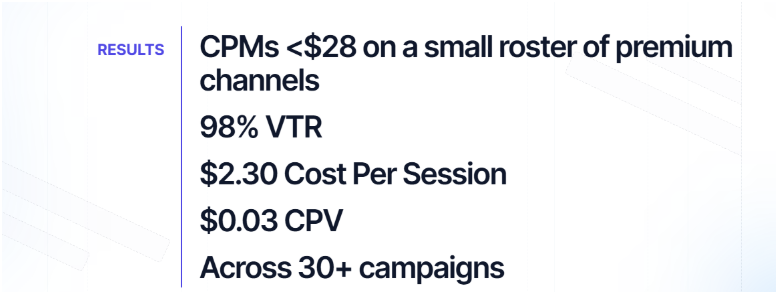
Read the full case study on Vibe.co
Understanding your TV ad’s performance helps you refine your strategy for better results. Now, let’s look at how much TV advertising costs and what factors impact pricing.
How Much Does It Cost to Advertise on TV?
TV advertising costs vary depending on where and how you run your ad.
Traditional TV ads follow a fixed pricing model based on airtime and audience size, while newer options like Connected TV (CTV) and programmatic ads offer more flexibility and better targeting.
Understanding these differences can help you choose the right option for your budget.
Cost of Traditional TV Ads
Traditional TV ads are priced based on several key factors:
- Network & Channel – National networks (like ABC, NBC, and FOX) charge more than local stations.
- Time Slot – Prime-time ads (7-10 PM) are more expensive than late-night or daytime ads.
- Audience Reach – The larger the audience, the higher the cost.
Here’s a breakdown of estimated costs for different types of TV ads:
| Type of TV Ad | Estimated Cost |
|---|---|
| Local TV Ad (Small Market) | $500 – $5,000 per ad |
| Regional TV Ad | $5,000 – $50,000 per ad |
| National TV Ad | $100,000 – $1M+ per ad |
If you are advertising locally, a small-market TV ad can cost as little as $500.
If you want a national presence, the costs increase significantly.
However, traditional TV ads lack precise targeting. You are paying to reach a broad audience, many of whom may not be interested in your product.
This is why many businesses are now shifting to CTV and programmatic ads.
Cost of Connected TV (CTV) & Programmatic TV Ads
CTV and programmatic advertising offer more control over who sees your ads.
Instead of paying for a general TV audience, you only pay for views from people who match your target audience.
- CTV Ads – You can run on streaming services like Hulu, Vibe.co, and YouTube TV, allowing targeted ad placements.
- Programmatic TV Ads – Use AI to place ads where they will perform best, reducing wasted spend.
Here’s how their pricing compares:
| Type of TV Ad | Column B |
|---|---|
| CTV Ads | $35 – $65 CPM |
| Programmatic TV Ads | $20 – $50 CPM |
For example, if you spend $5,000 on a CTV campaign with a $50 CPM, your ad will be seen 100,000 times by the right audience.
CTV and programmatic ads are more cost-effective than traditional TV ads because you’re only paying for targeted impressions, not wasted views.
Bonus tips for small businesses & startups:
If you're working with a limited budget, here’s how you can still advertise on TV:
1️. Start with Local or CTV Ads – Instead of national TV, use local TV or CTV to reach a more relevant audience at a lower cost.
2️. Use Programmatic Buying – Automated platforms help optimize spending by only showing ads to the right audience.
3️. Track & Adjust – Start small, measure performance, and adjust your budget based on what works best.
Here’s how Vibe.co helped a business save 50% on TV advertising:
Smartliner wanted to advertise on TV but had a limited budget. Instead of running expensive national TV ads, they partnered with Vibe.co to launch a Connected TV campaign.
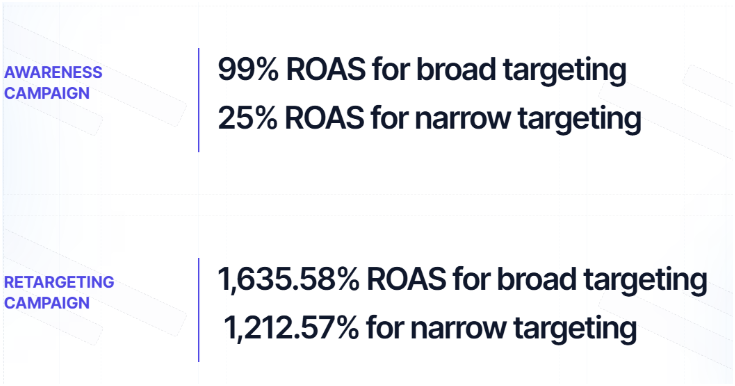
- By targeting only relevant viewers, they reduced wasted spend.
- They tracked engagement using QR codes, which helped them measure real results.
- In just a few weeks, they saw a 30% increase in website traffic and a 15% boost in conversions—all while spending 50% less than a traditional TV campaign.
Read the full case study on Vibe.co
TV advertising doesn’t have to be expensive.
By choosing the right ad type for your budget and audience, you can maximize your results without overspending.
Next, let’s explore the key differences between TV advertising and digital advertising.
TV Advertising vs. Digital Advertising: Which One Should You Choose?
TV and digital ads serve different purposes. TV builds brand awareness, while digital ads focus on direct response.
The best choice depends on your goal, budget, and audience.
| Factor | TV Advertising | Digital Advertising |
|---|---|---|
| Reach | Large, broad audience | Targeted, specific audience |
| Targeting | General demographics | Interests, behavior, location |
| Cost | Higher upfront | Flexible, pay-per-click |
| Best For | Brand awareness | Lead generation, direct sales |
| Tracking | Limited measurement | Real-time analytics & tracking |
Traditional TV ad buying has been slow, expensive, and difficult to optimize. That’s why modern solutions are changing how businesses approach TV advertising.
How Vibe.co Makes TV Advertising Smarter
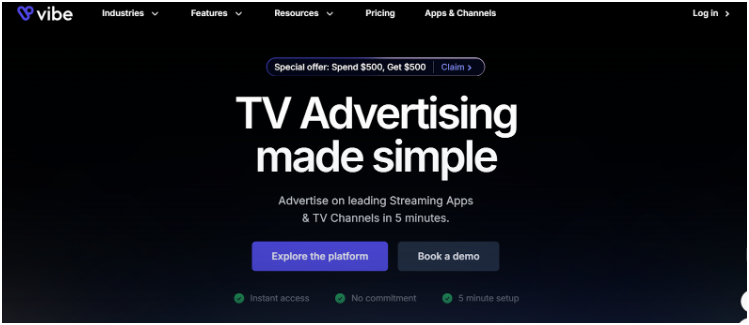
Businesses today need flexibility, real-time data, and precise audience targeting—just like they get with digital ads.
Vibe.co helps in TV ad buying and makes it as simple and measurable as running a digital campaign.
- You don’t need a big budget or a media agency. Just set up your campaign and go live in minutes.
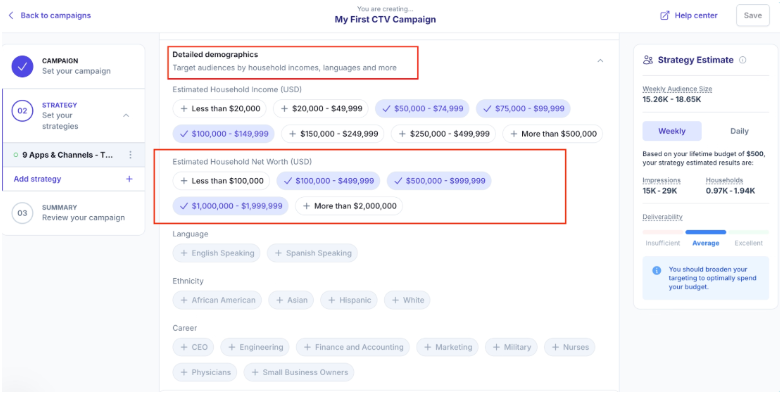
- Your ad reaches viewers based on location, demographics, interests, and behavior, just like digital ads.

- Start small with as little as $50 per day and increase spending based on what works.
- See exactly how many people viewed your ad and how they engaged with it. No more guessing.
- Get your ads on Hulu, Roku, and YouTube TV without expensive network deals.
And let’s suppose you don’t have a TV ad ready?
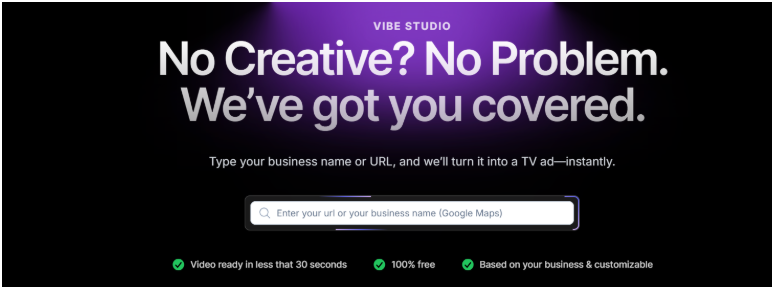
Vibe.co’s new feature, Vibe Studio, can help you generate a professional ad in seconds using your existing business information.
- AI-powered ad creation – You don’t need to hire a production team.
- Fast and cost-effective – You get a ready-to-air ad completely free.
- Optimized for TV and streaming – Ensure your ad meets the best creative standards for digital TV.
Whether you’re a small business, a startup, or an e-commerce brand, you can now run TV ads with the same control, targeting, and tracking as digital campaigns.
Conclusion
In this guide, we showed you how to advertise on TV—from choosing the right format to targeting the right audience and tracking performance like a digital campaign.
Here’s what you need to remember:
- TV still works, but traditional ad buying is outdated—slow negotiations, high costs, and little control.
- Connected TV (CTV) and programmatic ads now allow you to target specific audiences, track performance, and optimize spending.
- Costs vary based on placement, audience size, and ad type, but businesses can now start with small, flexible budgets.
- Measuring success is easier than ever—QR codes, analytics, and smart targeting help track real engagement.
But knowing how TV ads work is one thing. Running them efficiently is another.
With Vibe.co, you don’t need big budgets or media agencies.
You can launch, manage, and track TV ads just like you do with social media and paid search.
Platforms like Vibe.co allow businesses to run TV ads with greater control and targeting, similar to digital campaigns.
Small businesses can start with flexible budgets and real-time tracking. And No commercial? No problem.
Use Vibe Studio to create a professional ad instantly.
Want to see how easy TV advertising can be? Start your first campaign with Vibe.co today.
FAQs About Advertising on TV
- How much does it cost to advertise on TV?
Costs vary by network, time slot, ad duration, and audience size. National prime-time slots are pricier than local or off-peak ads, while streaming platforms offer more flexible pricing. - What’s the difference between traditional TV and CTV ads?
Traditional TV ads air on broadcast/cable channels, while CTV ads run on streaming platforms like Hulu and Roku, offering better targeting and tracking. - How can I target the right audience with TV ads?
CTV and programmatic ads let you target viewers by demographics, location, and behavior—just like digital ads. - Are TV ads effective for small businesses?
Yes, CTV and programmatic ads offer affordable options for small businesses to reach specific audiences with flexible budgets. - How do I measure the success of a TV ad?
Track impressions, engagement, website visits, and conversions. Use QR codes and unique URLs for direct response.


